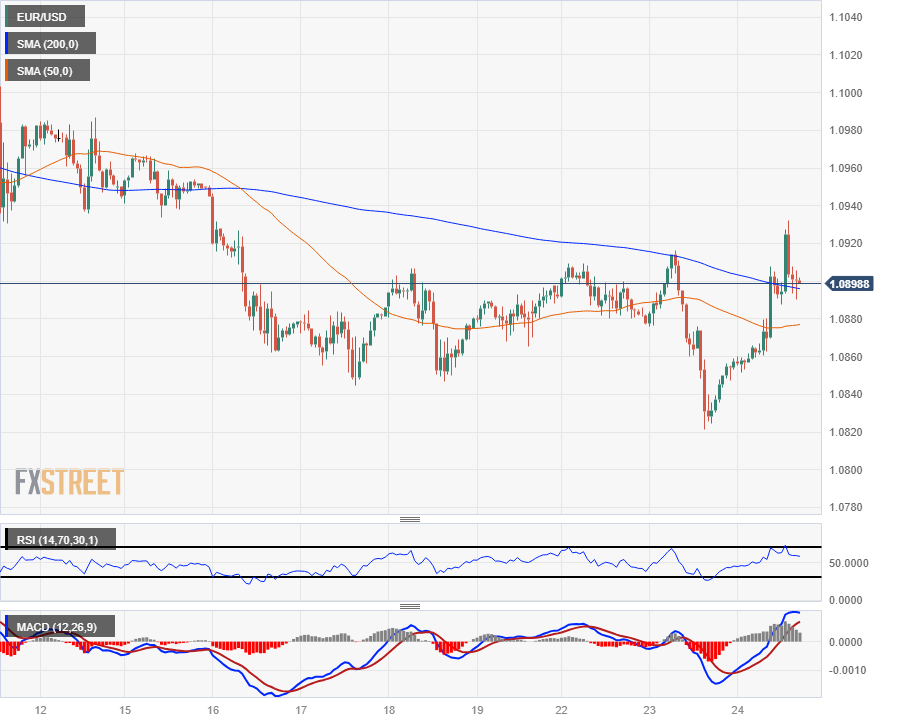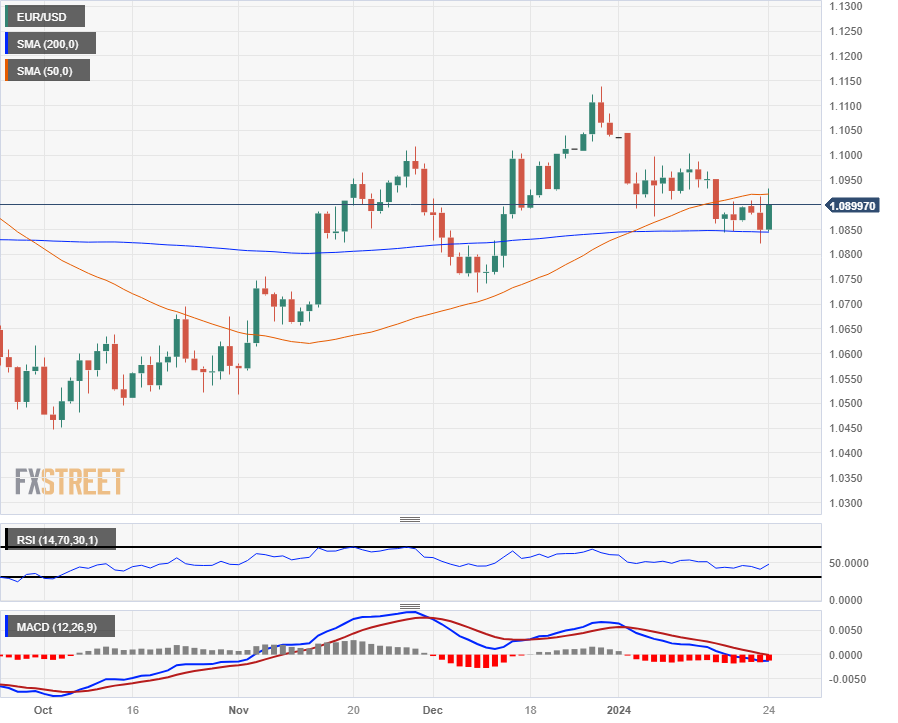- Аналітика
- Новини та інструменти
- Новини ринків
- EUR/USD rebounds into near-term median after US PMI surges above forecasts
EUR/USD rebounds into near-term median after US PMI surges above forecasts
- EUR/USD knocks back after a firm rally as safe-haven bids step up.
- US PMI beats take center stage as rate cut hopes wither further.
- A beat for the EU Manufacturing PMI helped kick off a EUR/USD climb.
The EUR/USD drove back into the high side near 1.0930 on Wednesday after markets shrugged off a miss for pan-European Purchasing Managers Index (PMI) figures before a follow-up beat in US PMIs sent risk appetite skidding back into the safe havens. The pair gained over a full percent bottom-to-top climbing from the previous day’s low of 1.0821 before getting pushed back into a familiar technical level near 1.0900.
European PMIs broadly printed in the sub-50.0 region, suggesting the broader euro area economy remains in contraction territory, and nearly all missed market expectations with the exception of a single bright spot in the manufacturing sector. Meanwhile, US PMIs broadly beat the Street, with a climb to multi-month highs in both manufactured goods and the service sector.
Daily digest market movers: EUR/USD rally gets cut short after US PMIs tarnish rate outlook once more
- European PMIs broadly missed expectations, but a beat in the Manufacturing PMI helped bolster the mood as investors search for a Euro win.
- The pan-European Manufacturing PMI printed at 46.6 in January, above the forecasted 44.8 and climbing even higher above the previous month’s 44.4.
- The Europe-wide PMI Services component fell to 48.4, missing the forecast of 49.0 and slipping back further from December’s 48.8.
- European Manufacturing PMIs climbed to a ten-month high, extending a recovery from multi-year lows and bolstering the Euro (EUR).
- US PMIs broadly beat market expectations to print healthy gains in business activity, crumpling rate cut hopes even further and sending traders back into the US Dollar in the mid-week market session.
- January’s US Manufacturing PMI climbed to a 15-month high of 50.3, returning to expansion territory above 50.0 and easily beating the market forecast of a steady print at December’s 47.9.
- The US Services PMI for January also jumped forecasts to print at 52.9 versus the forecasted decline from 51.4 to 51.0.
- EUR-based pairs will be turning to face Thursday’s European Central Bank (ECB) rate call.
- Markets are broadly looking for rate cuts from the ECB to begin sometime around the midpoint of 2024.
- ECB Preview: Forecasts from 12 major banks
Euro price today
The table below shows the percentage change of Euro (EUR) against listed major currencies today. Euro was the strongest against the Canadian Dollar.
| USD | EUR | GBP | CAD | AUD | JPY | NZD | CHF | |
| USD | -0.37% | -0.46% | 0.17% | -0.27% | -0.67% | -0.39% | -0.78% | |
| EUR | 0.37% | -0.09% | 0.53% | 0.06% | -0.29% | -0.03% | -0.42% | |
| GBP | 0.46% | 0.09% | 0.62% | 0.16% | -0.21% | 0.06% | -0.31% | |
| CAD | -0.17% | -0.51% | -0.62% | -0.47% | -0.84% | -0.57% | -0.95% | |
| AUD | 0.29% | -0.07% | -0.17% | 0.45% | -0.33% | -0.12% | -0.50% | |
| JPY | 0.65% | 0.28% | 0.21% | 0.79% | 0.38% | 0.25% | -0.13% | |
| NZD | 0.41% | 0.00% | -0.07% | 0.54% | 0.10% | -0.26% | -0.41% | |
| CHF | 0.78% | 0.41% | 0.32% | 0.94% | 0.50% | 0.12% | 0.39% |
The heat map shows percentage changes of major currencies against each other. The base currency is picked from the left column, while the quote currency is picked from the top row. For example, if you pick the Euro from the left column and move along the horizontal line to the Japanese Yen, the percentage change displayed in the box will represent EUR (base)/JPY (quote).
Technical Outlook: EUR/USD continues to splash around in tight congestion zone
EUR/USD finds itself getting dumped back into the 1.0900 handle near the 200-hour Simple Moving Average (SMA) on Wednesday as the pair struggles to find real momentum, keeping the pair pinned to near-term technical levels amidst a broader push into mid-term consolidation. A widening consolidation range is highlighting the increased volatility in the EUR/USD despite keeping the pair close to long-term support near 1.0850.
Daily candlesticks have the EUR/USD stuck in the middle of a consolidation pattern between the 50-day and 200-day SMAs at 1.0920 and 1.0850, respectively. The Euro-Dollar pair is set to drift until a meaningful push develops in either direction.
EUR/USD Hourly Chart
EUR/USD Daily Chart
Euro FAQs
What is the Euro?
The Euro is the currency for the 20 European Union countries that belong to the Eurozone. It is the second most heavily traded currency in the world behind the US Dollar. In 2022, it accounted for 31% of all foreign exchange transactions, with an average daily turnover of over $2.2 trillion a day.
EUR/USD is the most heavily traded currency pair in the world, accounting for an estimated 30% off all transactions, followed by EUR/JPY (4%), EUR/GBP (3%) and EUR/AUD (2%).
What is the ECB and how does it impact the Euro?
The European Central Bank (ECB) in Frankfurt, Germany, is the reserve bank for the Eurozone. The ECB sets interest rates and manages monetary policy.
The ECB’s primary mandate is to maintain price stability, which means either controlling inflation or stimulating growth. Its primary tool is the raising or lowering of interest rates. Relatively high interest rates – or the expectation of higher rates – will usually benefit the Euro and vice versa.
The ECB Governing Council makes monetary policy decisions at meetings held eight times a year. Decisions are made by heads of the Eurozone national banks and six permanent members, including the President of the ECB, Christine Lagarde.
How does inflation data impact the value of the Euro?
Eurozone inflation data, measured by the Harmonized Index of Consumer Prices (HICP), is an important econometric for the Euro. If inflation rises more than expected, especially if above the ECB’s 2% target, it obliges the ECB to raise interest rates to bring it back under control.
Relatively high interest rates compared to its counterparts will usually benefit the Euro, as it makes the region more attractive as a place for global investors to park their money.
How does economic data influence the value of the Euro?
Data releases gauge the health of the economy and can impact on the Euro. Indicators such as GDP, Manufacturing and Services PMIs, employment, and consumer sentiment surveys can all influence the direction of the single currency.
A strong economy is good for the Euro. Not only does it attract more foreign investment but it may encourage the ECB to put up interest rates, which will directly strengthen the Euro. Otherwise, if economic data is weak, the Euro is likely to fall.
Economic data for the four largest economies in the euro area (Germany, France, Italy and Spain) are especially significant, as they account for 75% of the Eurozone’s economy.
How does the Trade Balance impact the Euro?
Another significant data release for the Euro is the Trade Balance. This indicator measures the difference between what a country earns from its exports and what it spends on imports over a given period.
If a country produces highly sought after exports then its currency will gain in value purely from the extra demand created from foreign buyers seeking to purchase these goods. Therefore, a positive net Trade Balance strengthens a currency and vice versa for a negative balance.
© 2000-2025. Уcі права захищені.
Cайт знаходитьcя під керуванням TeleTrade DJ. LLC 2351 LLC 2022 (Euro House, Richmond Hill Road, Kingstown, VC0100, St. Vincent and the Grenadines).
Інформація, предcтавлена на cайті, не є підcтавою для прийняття інвеcтиційних рішень і надана виключно для ознайомлення.
Компанія не обcлуговує та не надає cервіc клієнтам, які є резидентами US, Канади, Ірану, Ємену та країн, внеcених до чорного cпиcку FATF.
Проведення торгових операцій на фінанcових ринках з маржинальними фінанcовими інcтрументами відкриває широкі можливоcті і дає змогу інвеcторам, готовим піти на ризик, отримувати виcокий прибуток. Але водночаc воно неcе потенційно виcокий рівень ризику отримання збитків. Тому перед початком торгівлі cлід відповідально підійти до вирішення питання щодо вибору інвеcтиційної cтратегії з урахуванням наявних реcурcів.
Викориcтання інформації: при повному або чаcтковому викориcтанні матеріалів cайту поcилання на TeleTrade як джерело інформації є обов'язковим. Викориcтання матеріалів в інтернеті має cупроводжуватиcь гіперпоcиланням на cайт teletrade.org. Автоматичний імпорт матеріалів та інформації із cайту заборонено.
З уcіх питань звертайтеcь за адреcою pr@teletrade.global.















